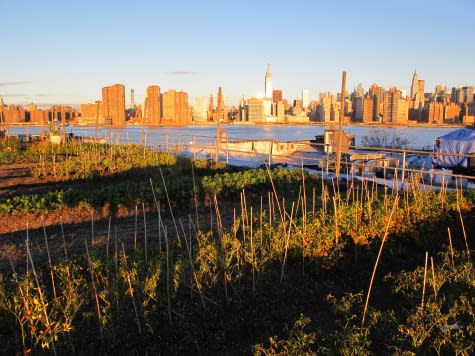Roof-top farming: Part of the future of inner-city living
Over the last decade or so, petrol prices have more than doubled and the amount of available and accessible agricultural land has decreased mainly due to suburban sprawl extending further and further away from the major city centres where the majority of our population reside. This invariably has placed cost pressures on the price of fresh produce, increases the environmental impacts through greenhouse gas emissions and puts pressure on the cost of living. To combat this, the most sensible option would be to bring accessible agricultural land closer to the city centres however a combination of high land prices and a shortage in suitable farming land makes this option close to impossible to achieve.
Roof-tops are generally seen as the most ideal locations for setting up farms as they are usually the least occupied areas and have generous amounts of sunlight and rain which are essential to a thriving garden. In recent times, there have been many initiatives to incorporate community gardens in existing areas and residential buildings including the Pop-Up Patch located at the Federation Square car park where inner city dwellers rent out veggie patches made from apple containers and pay a modest fee. Another noteable example is the Eagle Street roof-top farm located on a warehouse roof in Greenpoint, Brooklyn in New York City (pictured above). According to the farms fact sheet, the farm comprises of an approximate area of 6,000 square feet (approximately 557 square metres) and provides ultra local fresh produce to the North Brooklyn community along with providing educational programs on how to grow and maintain an urban farm. Furthermore, the initial start up costs for getting the farm up and running was approximately AUD$9.52 per square metre (USD$0.90 per square foot based on a conversion rate of $1 AUD to $1.05 USD) however it was noted that this costing was far cheaper than a standard installations due to the use of recycled materials where possible.
The aforementioned examples demonstrate how existing structures could potentially be utilised to incorporate roof-top farms however the next challenge is to incorporate these roof-top farms into new developments and potentially introducing planning policies or state government tax cuts to encourage developers to incorporate community farms into proposed residential developments. Some of the potential benefits for such initiatives could include:
- Local food production for the community living within the residential building which will be available to all residents and could even potentially be used as a source of income.
- Increased community engagement by residents with them working together to care for the farms.
- Increased health and well-being.
- Reduced rainwater run-off from the roof as the water will be either captured in the garden beds and/or captured in rainwater tanks which could be used during the drier months of the year.
- Environmental impact may be reduced due to the elimination of the need to transport the produce from a farm in a provinicial area to the city centres.
- Through the use of educational programs, residents can learn new farming skills and pass those skills onto others.
A group of Melbourne urban professionals teamed up recently to consider the viability of establishing an urban rooftop farms. Inspired by the City of Melbourne's ambitions to be a "green city"; Pippa Howard, Nicky Scheltus and Alex Houlston have combined their powers along with Russell Hughes, to come up with a plan to develop a sustainable rooftop farm. "imagine rooftop gardens and other dead spaces being put to use growing fresh fruit and vegetables for sale to city swellers" said Pippa, an architect and part time lecturer in environmental design.
The group is preparing a business model for developing an urban farm over the Queen Victoria Market car park which is approximately 2.5 hectares in area. "The Queen Victoria Market is a fantastic case study of how you can make a city much more self-reliant in terms of food supply as well as creating a vibrant and exciting urban space" said Alex who has a strong background in urban design. Further: "Our case study will examine opportunities such as building a lightweight, tiered structure on top of the car park, or potentially redeveloping the site for the community's advantage with a rooftop produce garden, bio-digester and cogeneration boiler. The goal would be to provide food products to vendors at the market for a management fee, meaning we would not compete with stallholders and we would save on transportation costs and emissions".
This is one example of how under-utilised spaces in inner city Melbourne could be activated into productive, vibrant areas.
Further to this, recent residential proposals, in particular the Footscray Market Redevelopment which will be constructed by Hacer Group and due for completion by 2014, comprises a two stage redevelopment including the refurbishment of the existing Footscray Market and the addition of a five storey residential component built using an ultra light weight steel frame. The communal courtyard incorporates a sun filled roof top farm which looks back to the areas history as a fresh produce market whilst looking forward as a sustainable inner city farming solution.
Although roof-top farming can be seen as simple and easily applicable response to Melbourne's sustainability vision, the biggest challenge for stakeholders and policy makers will be engaging and motivating our community to see these types of approaches as the "way of the future" and as a necessary "way of life". However in my opinion, I believe that in the not too distant future that these types of initiatives will be a necessity rather than a option as we grow into a more sustainable, urbanised Melbourne.
Sources and further reading
- http://www.csl.org.au/2009/11/urban-farming/
- http://www.nockdoig.com.au/diy-rooftop-gardens/
- http://www.bureau-ua.com/Footscray.html
- http://rooftopfarms.org/
